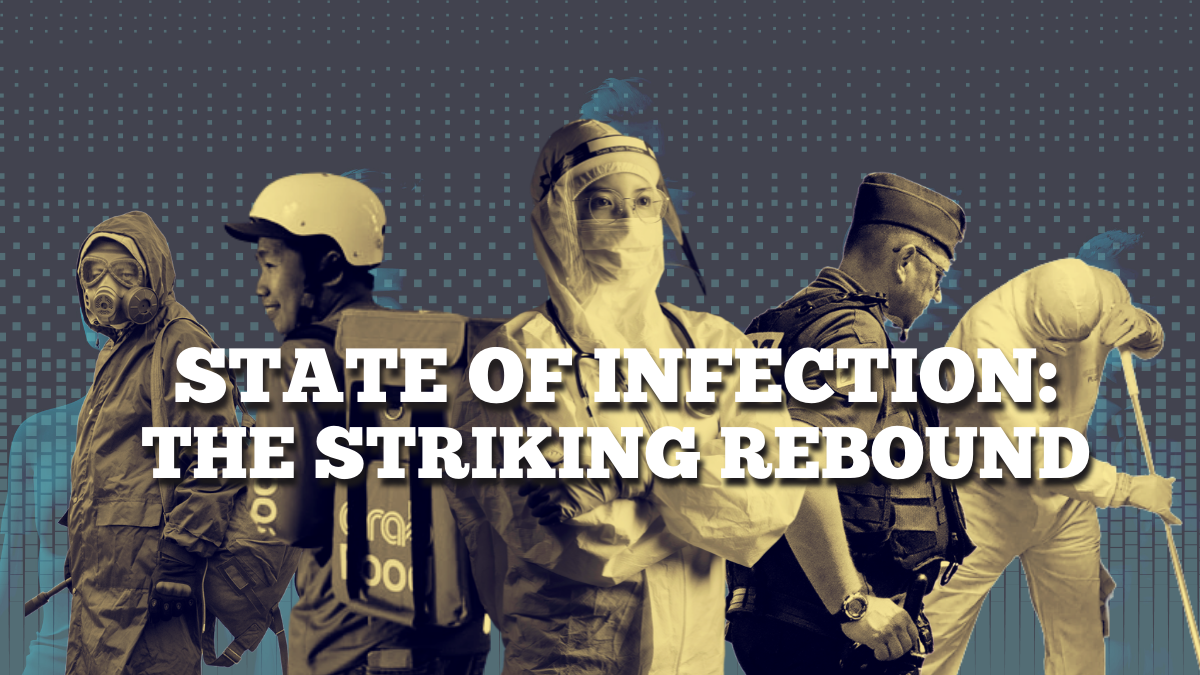
Colors in Politics: The Whys and its Origin
April 9, 2022
State of Infections: The Uneven Trail
July 6, 2022State of Infections: The Striking Rebound

“A new year is a new beginning” — a phrase that we often see whenever the calendar strikes on the first of January — ignites hope, faith, and optimism. However, as we welcome the new year, we also celebrate it with a new COVID-19 variant that has just entered our playing field, bringing a tight obstacle straight into our first game for the season.
With half of the population already armed with the defense of the vaccines, which court would the ball roll? Would it lead us to see the end of this pandemic, or would we be stuck in this game of masks and social distancing? To find out, let us replay the game highlights and see how the first quarter of the season 2022 unfolds.
Entering the Ring
January 1
The Philippines welcomes 2022 with 3,617 new COVID-19 cases, the highest number of new cases reported in a day since October 30, 2021, wherein 4,008 new cases were announced.
The rise in cases stimulates the concern of the health authorities. The health department said that the highly contagious disease Omicron variant has a high potential to enter the Philippines.
January 8
According to the statement of Jonas del Rosario, the Philippine General Hospital’s (PGH) “crisis response” to the occurring COVID-19 outbreak is to maintain the frontliners on duty as long as there are no symptoms detected.
Del Rosario added that the PGH could not handle losing the remaining employees due to the hospital’s significant increase in new admissions.
January 10
The COVID-19 pandemic interrupted the operations of businesses — in banks, malls, and airlines and decreased the functions of the school.
The Philippines also announced 33,169 new coronavirus cases, increasing its overall record to almost three million, as the Omicron variant also entered the nation. The virus greatly affected the capital of the country, Manila, and its nearest provinces.
January 16
On Sunday, the country’s total cases of COVID-19 virus surpassed 3.2 million, while new cases are above 30,000 for the fifth day in a row.
January 20
The three Cordillera provinces and Northern Samar province in the Visayas have been escalated to Alert Level 4, signifying the intensity of the COVID-19 epidemic on local healthcare systems.
January 22
According to the OCTA Research group, Metro Manila is still at the center of critical disposition due to COVID-19, based on the average daily rate.
Soaring from Defeat
January 28
According to the Health Undersecretary Maria Vergeire, the usual average daily rate of the COVID-19 cases in the capital region has decreased by 67% in the past week.
January 31
One year after the availability of the COVID-19 vaccines, the country continues to face a series of challenges. Meanwhile, some regions, such as Metro Manila, have reached at least half of the intended target population, while eight or almost half of the 17 areas remain unsteady.
February 1
The Department of Health (DOH) has announced a new confirmed case of 9,493, increasing the nation’s total tally to 3,569,665.
February 8
The national government has announced a new price for the COVID-19 rapid antigen testing, reducing its price from P960 to P660. This also covers the service fee, while the diagnostic test kit costs P350.
February 13
The Philippines has achieved its lowest single-day tally for this year, reporting at least 3,050 cases, with no new deaths related to coronavirus disease.
Strengthening the Defense
February 15
Health Secretary Francisco Duque III stated that all regions in the Philippines are at low risk except for areas under moderate risk classification, namely: Region 11 (Davao), Cordillera Administrative Region (CAR), Region 6 (Western Visayas), and Region 12 (Soccsksargen).
February 16
As of this date, fully vaccinated foreigners’ entry into the Philippines is permitted.
February 17
Several government-owned COVID-19 treatment hospitals in Quezon City were given additional funds totaling P1.3 billion this year as per the 2022 national budget.
February 20
According to Major General Vicente Danao Jr., chief of the National Capital Region Police Office (NCRPO), 99.41% or 23,414 NCRPO personnel are fully vaccinated. In contrast, fully vaccinated personnel of the Philippine National Police (PNP) are 219,914 or 97.79%.
February 28
Health Undersecretary Maria Rosario Vergeire stated that the COVID-19 pandemic is not yet over, and the Philippines is yet to reach the endemic state of the virus.
On Monday, this statement was said after the Inter-Agency Task Force for the Management of Emerging Infectious Diseases (IATF-EID) classified Metro Manila and 38 other areas under Alert level 1 status from March 1 to 15.
Igniting the Torch
March 1
Estimated earnings of P9.4 billion per week of economic activity in gross value-added terms are anticipated due to the shift of most regions in the country to Alert Level 1 status, the National Economic and Development Authority (NEDA) said.
March 2
The once rigid restrictions have become more relaxed as places of worship, restaurants, and public transport are now allowed to operate at full capacity.
March 15
According to Metropolitan Manila Development Authority (MMDA), all local governments of the 17 cities and municipalities under the National Capital Region (NCR) are prepared for a possible shift from Alert Level 1 to Alert Level Zero as a continuous downtrend of COVID-19 cases is being realized.
March 18
Although there is a decline in the unemployment rate in the country, fewer Filipinos are still able to work despite the surge of Omicron in January 2022, the National Economic and Development Authority (NEDA) stated.
March 20
In the statement of OCTA Research Group on Sunday, the Philippines remained at a very low-risk classification for COVID-19 cases.
Chasing Victory
March 23
As of this date, 10,196 (9,994 public; 212 private) schools have already conducted limited face-to-face classes, while 14,396 public and private schools were nominated last Tuesday for inclusion in the progressive expansion.
March 27
According to the National Task Force against COVID-19, the Philippines received 1.2 million doses of Pfizer vaccine last Saturday allocated for pediatric inoculation.
March 28
Based on COVID-19 Situation Report #98 garnered from World Health Organization (WHO), 65% of the target population (5 years and older) in the Philippines were fully vaccinated.
Over 94% are fully vaccinated for healthcare workers, while 48% of this portion received their booster dose.
March 29
The nationwide average daily COVID-19 cases are about 70 to 268; however, if the public fails to comply with the minimum public health standards, the daily infections might surge up to 270, Health Undersecretary Maria Rosario Vergeire said.
March 30
NCR and 47 areas nationwide were put under Alert level 1 status from March 16-31, 2022.
The IATF-EID has yet to announce the nationwide Alert Level system for April.
The first quarter of 2022 has indeed been eventful — it made us hold on to our seats when the cases spiked and made our hearts race as we anticipated another possible lockdown from the increasing alert levels in its first half. But subsequently, an unexpected comeback occurred. With vaccines serving as our added shields, the COVID-19 enemy has weakened in numbers, letting us re-open our gates and blazing our spirit of hope once again. However, the season has barely begun, and as we enter the new quarter of the year, may we be reminded that vaccines alone are not the solution. As players of this pandemic, we must continue to stick to our game plan and health protocols, ultimately beating the opponent and claiming victory.
LAYOUT BY: Quina Capane
PHOTO SOURCE(S): Pexel, ABS-CBN


